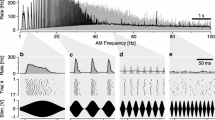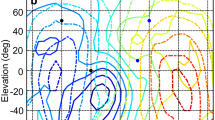Summary
-
1.
Primary auditory-nerve fibres of the bobtail lizard have asymmetrical, V-shaped frequency-threshold tuning curves. Fibre characteristic frequencies (CF) ranged from 0.2 to 4.5 kHz. The most sensitive fibres had a CF near 1.2 kHz and a threshold of 6 dB SPL.
-
2.
Fibres with CFs below 0.85 kHz had simple U-shaped tuning curves; higher-CF fibres had tuning curves with obvious sharp tips around CF. These tips were up to 46 dB in depth. Several other parameters of the tuning curves, like the selectivity coefficients Q10 dB and Q40 dB and the course of the tuning curve flanks, also permit a separation into the same low-CF and high-CF groups.
-
3.
The tuning sharpness and the thresholds of both low- and high-CF fibres were hypoxia-sensitive, the loss of sensitivity being greatest at CF.
-
4.
Only the low-CF group of fibres showed two-tone rate suppression. In those fibres, two-tone rate suppression was only found with suppressor frequencies above CF, but not below CF.
Similar content being viewed by others
Abbreviations
- CF :
-
characteristic frequency
- TTRS :
-
two-tone rate suppression
References
Abbas PJ, Sachs MB (1976) Two-tone suppression in auditorynerve fibers: Extension of a stimulus-response relationship. J Acoust Soc Am 59:112–122
Cleveland WS (1979) Robust locally weighted regression and smoothing scatterplots. J Amer Stat Assoc 74:829–836
Crawford AC, Fettiplace R (1980) The frequency selectivity of auditory nerve fibres and hair cells in the cochlea of the turtle. J Physiol 306:79–125
Crawford AC, Fettiplace R (1981) An electrical tuning mechanism in turtle cochlear hair cells. J Physiol 312:377–412
Eatock RA, Manley GA, Pawson L (1981) Auditory-nerve fibre activity in the Tokay gecko: I. Implications for cochlear processing. J Comp Physiol 142:203–218
Evans EF (1972) The frequency response and other properties of single fibres in the guinea-pig cochlear nerve. J Physiol 226:263–287
Fettiplace R (1987) Electrical tuning of hair cells in the inner ear. Trends Neurosci 10:421–425
Frishkopf LS, DeRosier DJ (1983) Mechanical tuning of freestanding stereociliary bundles and frequency analysis in the alligator lizard cochlea. Hearing Res 12:393–404
Hill KG, Mo J, Stange G (1989) Induced suppression in spike responses to tone-on-noise stimuli in the auditory nerve of the pigeon. Hearing Res 39:49–62
Holton T (1980) Relations between frequency selectivity and two tone rate suppression in lizard cochlear-nerve fibres. Hearing Res 2:21–38
Holton T, Hudspeth AJ (1983) A micromechanical contribution to cochlear tuning and tonotopic organization. Science 222:508–510
Holton T, Weiss TF (1983) Frequency selectivity of hair cells and nerve fibres in the alligator lizard cochlea. J Physiol 345:241–260
Javel E, Geisler CD, Ravindran A (1978) Two-tone suppression in auditory nerve of the cat: Rate-intensity and temporal analyses. J Acoust Soc Am 63:1093–1104
Johnstone JR, Johnstone BM (1969) Unit responses from the lizard auditory nerve. Exp Neurol 24:528–537
Klinke R, Pause M (1980) Discharge properties of primary auditory fibres in Caiman crocodilus: comparisons and contrasts to the mammalian auditory nerve. Exp Brain Res 38:137–150
Köppl C (1988) Morphology of the basilar papilla of the bobtail lizard Tiliqua rugosa. Hearing Res 35:209–228
Köppl C, Manley GA (1990a) Peripheral auditory processing in the bobtail lizard Tiliqua rugosa. II. Tonotopic organization and innervation pattern of the basilar papilla. J Comp Physiol A 167:101–112
Köppl C, Manley GA (1990b) Peripheral auditory processing in the bobtail lizard Tiliqua rugosa. III. Patterns of spontaneous and tone-evoked nerve-fibre activity. J Comp Physiol A 167:113–127
Köppl C, Manley GA (1990c) Functional consequences of morphological trends in the evolution of lizard hearing organs. In: Fay RR, Popper A, Webster DB (eds) The evolutionary biology of hearing. Springer, Berlin Heidelberg New York in press
Köppl C, Manley GA, Johnstone BM (1990) Peripheral auditory processing in the bobtail lizard Tiliqua rugosa. V. Seasonal effects of anaesthesia. J Comp Physiol A 167:139–144
Liberman MC (1978) Auditory-nerve response from cats raised in a low-noise chamber. J Acoust Soc Am 63:442–455
Manley GA (1977) Response patterns and peripheral origin of auditory nerve fibres in the monitor lizard, Varanus bengalensis. J Comp Physiol 118:249–260
Manley GA (1981) A review of the auditory physiology of the reptiles. Progr Sens Physiol 2:49–134
Manley GA (1986) The evolution of the mechanisms of frequency selectivity in vertebrates. In: Moore BCJ, Patterson RD (eds) Auditory frequency selectivity. Plenum Press, New York, London, pp 63–72
Manley GA (1990) Peripheral hearing mechanisms in reptiles and birds. Springer, Berlin Heidelberg New York
Manley GA, Leppelsack HJ, Gleich O, Oeckinghaus H (1985) Activity patterns of cochlear ganglion neurones in the starling. J Comp Physiol A 157:161–181
Manley GA, Yates GK, Köppl C (1988) Auditory peripheral tuning: evidence for a simple resonance phenomenon in the lizard Tiliqua. Hearing Res 33:181–190
Manley GA, Köppl C, Yates GK (1989) Micromechanical basis of high-frequency tuning in the bobtail lizard. In: Wilson JP, Kemp D (eds) Cochlear mechanisms, structure, function and models. Plenum Press, New York, pp 143–150
Manley GA, Yates GK, Köppl C, Johnstone BM (1990) Peripheral auditory processing in the bobtail lizard Tiliqua rugosa. IV. Phase-locking of auditory-nerve fibres. J Comp Physiol A 167:129–138
Miller MR (1980) The reptilian cochlear duct. In: Popper AN, Fay RR (eds) Comparative studies of hearing in vertebrates. Springer, Berlin Heidelberg New York, pp 169–204
Miller MR (1985) Quantitative studies of auditory hair cells and nerves in lizards. J Comp Neurol 232:1–24
Mulroy MJ (1974) Cochlear anatomy of the alligator lizard. Brain Behav Evol 10:69–87
Robertson D, Manley GA (1974) Manipulation of frequency analysis in the cochlear ganglion of the guinea pig. J Comp Physiol 91:363–375
Sachs MB, Young ED, Lewis RH (1974) Discharge patterns of single fibres in the pigeon auditory nerve. Brain Res 70:431–447
Schmiedt RA (1982) Boundaries of two-tone rate suppression of cochlear-nerve activity. Hearing Res 7:335–351
Turner RG (1987) Neural tuning in the granite spiny lizard. Hearing Res 26:287–299
Weiss TF, Leong R (1985) A model for signal transmission in an ear having hair cells with free-standing stereocilia. III. Micromechanical stage. Hearing Res 20:157–174
Weiss TF, Mulroy MJ, Turner RG, Pike CL (1976) Tuning of single fibres in the cochlear nerve of the alligator lizard: relation to receptor morphology. Brain Res 115:71–90
Wever EG (1978) The reptile ear. Princeton University Press, Princeton, N.J.
Author information
Authors and Affiliations
Rights and permissions
About this article
Cite this article
Manley, G.A., Köppl, C. & Johnstone, B.M. Peripheral auditory processing in the bobtail lizard Tiliqua rugosa . J Comp Physiol A 167, 89–99 (1990). https://doi.org/10.1007/BF00192409
Accepted:
Issue Date:
DOI: https://doi.org/10.1007/BF00192409




